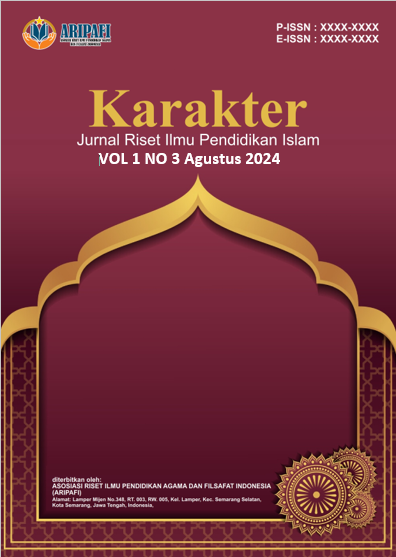Air Zam-zam dalam Perspektif Hadis dan Sains
Upaya Mendamaikan Agama dan Sains
DOI:
https://doi.org/10.61132/karakter.v1i3.54Keywords:
Zamzam water, hadith, scienceAbstract
Zam-Zam water is water that appeared during the period of Prophet Ismail AS., long before the birth of Prophet Muhammad SAW. Zam-zam water has received direct testimony and justification from the Prophet Muhammad as the best water on earth which contains many benefits. Explicitly, the properties of Zam-Zam water are contained in the hadith, which is considered authentic according to the scholars. This article, in an integrative-interconnective manner, tries to examine the existence of Zam-Zam water through a hadith perspective and a scientific perspective. From a hadith perspective, zam-zam water will be studied using several hadith critical methodologies, both in terms of the text of the hadith (matn) and the transmission of the narrator (sanad). Meanwhile, through a scientific approach, Zam-Zam water will be researched more deeply so that a scientific fact can be found that the substances contained and the molecules that are arranged in Zam-Zam water are better than other substances or water molecules. In this article, this will be proven, among other things, by the results of research by Masaru Emuto, a water expert from Japan, regarding the power of water in general, the magic of Zam-Zam water, and the beauty of the crystals that Zam-Zam water forms. So, the Prophet Muhammad’s justification for Zam-Zam water is embodied by the truth of modern scientific research facts. So it can be said that the agenda to reconcile religion and science is not in vain.
References
Al-Albani, N. (1997). Shahih Sunan Ibn Majah. Riyadh: Maktabah al-Ma’arif.
Al-Mizzi, J. (1992). Tahdzib al-Kamal. Beirut: Muassasah al-Risalah.
Al-Najjar, Z. (2006). Pembuktian sains dalam sunnah. Jakarta: Amzah.
Al-Sindi, A. al-H. bin A. H., et al. (2007). Syuruh Sunan Ibn Majah. Yordania: Baitul Afkar al-Dauliyah.
Al-Zuhair, N., et al. (n.d.). A comparative study between the chemical composition of potable water and zam-zam water in Saudi Arabia.
Aziz Ahmad, M. A., et al. (1997). Khasiat dan keutamaan air zam-zam. Jakarta: PT Lentera Basritama.
Bakdasy, S. (2000). Fadhl Ma’ Zam-zam. Beirut: Dar al-Basyair al-Islamiyah.
Caisaria, J., Junaidi, et al. (2016). Studi perbandingan kadar logam arsenik (As) dan besi (Fe) pada air zam-zam yang diperdagangkan dan air zam-zam Mekah melalui metode inductively coupled plasma-mass spectrometry (ICP-MS). Prosiding Seminar Nasional Kimia dan Pendidikan Kimia 2016. Unimed Press.
Emoto, M. (2006). The true power of water. Bandung: MQ Publishing.
Haryadi, Y., et al. (2007). The untrue power of water. Jakarta: Hikmah.
Ibn Majah, M. ibn Y. (2014). Al-Sunan. Kairo: Markaz Al-Buhuts wa Taqniyah Al-Ma’lumat.
Istarani, F., et al. (2014). Studi dampak arsen (As) dan kadmium (Cd) terhadap penurunan kualitas lingkungan. Jurnal Teknik Pomits, 3(1).
Jannah, D. S. N. (2018). Air zam-zam dalam hadis Sunan Ibn Majah nomor 3053 (Skripsi, Prodi Ilmu Hadis, UIN Sunan Ampel).
Muhammad Hamu, M., et al. (2011). Zam-zam tarikh wa fadhail. Mekah.
Rasyida, K., et al. (2014). Deteksi kemurnian air zam-zam menggunakan metode spektrofotometri Fourier transform infrared (FTIR) dan kemometrik (Detection of zam-zam water purity using Fourier transform infrared (FTIR) spectroscopy technique and chemometrics). e-Jurnal Pustaka Kesehatan, 2(2).
Ritongga, P. S. (2011). Air sebagai sarana peningkatan imtaq (Integrasi kimia dan agama). Jurnal Sosial Budaya, 8(2).
Yazid, E. A. (2017). Optimasi pH pada penentuan magnesium dalam air zam-zam secara spektrofotometri visibel. Jurnal Sains, 7(13)






